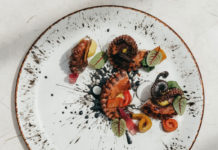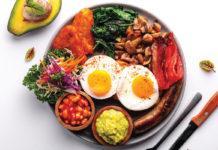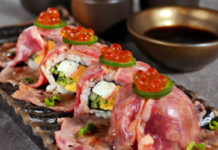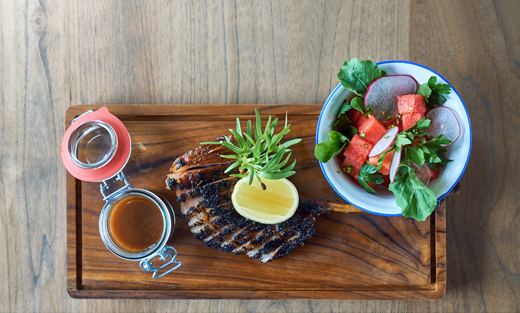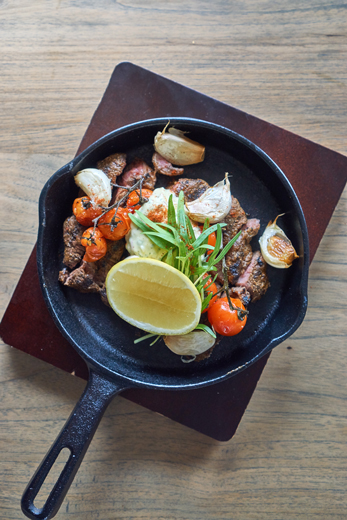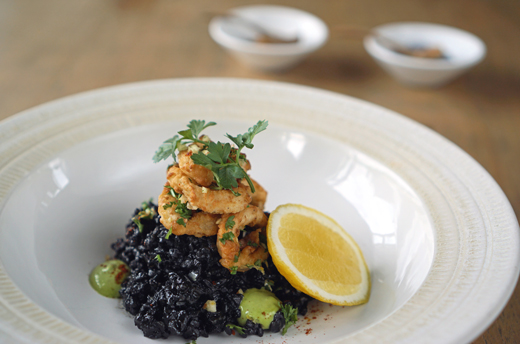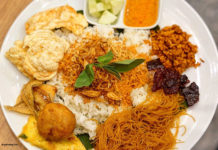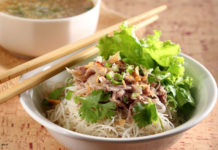A Chef’s Tale : Here Comes The Rain
It’s raining chefs in the lush hills of Ubud, Bali. Asia’s beloved Street Food Chef, Will Meyrick, has transported his “chef-in-crime” Palm Amatawet, together with Chef Tim Bartholomew, to the kitchen of Hujan Locale, his latest culinary baby in the centre of town.
Following a string of successful Asian restaurants—the award-winning flagship Sarong and its younger sister Mama San in Bali, the E&O (Eastern & Oriental) in Jakarta and the second Mama San in Hong Kong—plus a second print run of his cookbook “Sarong Inspirations” and starring roles on Indonesian TV programs, Chef Will shows no signs of slowing down.
Hujan, meaning rain, is created out of Chef Will’s desire to return to the art of slow grassroots cooking in smaller restaurants. At Hujan, Bali’s tropical rain symbolizes good fortune and prosperity, refreshing its farms and fields and nourishing its residents with nature’s bounty. Adopting the found-and-foraged culinary movement, Chef Will sources his seasonal ingredients sustainably from local farmers with whom he has fostered close relationships over the past three years.
Hujan’s menu is a tribute to the rain and the abundant harvest bestowed upon the island, featuring a simple fusion fare of east meets west, merging Chef Will’s love of Asian food with his Scottish background as well as showcasing Indonesian cuisine with his signature style. Everything is made in-house whenever possible.
We recommend starting with a round of Hujan’s creative cocktails. Try the coconut mojito, the cucumber martini, the brem Negroni, made from fermented glutinous rice mixed with gin and Campari, or the carrot swizel, a concoction of vodka, lemon, vanilla, chilli, Thai basil and homemade carrot soda served artfully with a handful of wafer-thin carrot candy.
Expect adventurous, generously portioned starters such as the crispy chilli and fennel pig’s ears, the heritage black pudding served on a betel leaf, the wood-roasted bone marrow topped with breadcrumbs and gentlemen’s relish, the Portuguese squid ink rice with crispy calamari (continue reading for the recipe) and the Sri Lankan cured scallops with mint, shredded coconut, lime juice and salmon roe.
The mains read like comfort foods sourced from the earth and oceans. Some of our favourites include the roasted sea bass with house-smoked pork belly, the crispy Sumatran duck with spiced cassava leaf curry, the melt-in-your-mouth slow-braised soy beef cheek with wasabi green pea risotto, the scrumptious honey-roasted pork hock with highland black pudding and the delectable hand-rolled tagliatelle with chorizo duck egg, parmesan and truffle oil. Save some room for the best bread-and-butter pudding in town served with whiskey and maple syrup ice cream, or sample other popular desserts such as the dark sticky bourbon and cola pudding with rum and raisin ice cream, the orange and chocolate Oreo cheesecake and the lemon and passion fruit curd tart.
The interior of Hujan has the nostalgic feel of an inherited French-colonial mansion with an old-world Asian charm in the Vietnamese countryside. The revamped two-storey lofty space reflects an understated tropical elegance with its beautiful wooden shutters, recycled teak panelling and a cool green-and-grey colour palette enlivened with splashes of pomegranate and citrus. The space is granted a slight edgy vibe with provincial-meets-urban touches of linear drawings, vintage botanical prints, a large distressed mirror with studded brass pins, an eye-catching centrepiece of M.C. Escher’s “Palm” and a photograph of “Morning Rain” by renowned Indonesian photographer Hengki Koentjoro.
“There is no such thing as bad weather, only different kinds of good weather,” said John Ruskin. Embrace Bali’s rainy season. Smell the freshly showered earth, listen to the rhythmic raindrops falling on Hujan’s French-style windowpanes and relish a drizzly evening of gastronomic debauchery.
__________________________________________________________
What’s Eating Will Meyrick
Chef Will Meyrick lives, breathes and eats street food and there is no better chef to bring Indonesia’s diverse cultures together through cuisine. We checked in with The Street Food Chef at the newly opened Hujan Locale while waiting out the torrential rain.
__________________________________________________________________
Q: What brought about your fifth restaurant, Hujan Locale?
A: We are working closely with local farmers, honouring the relationship. Hujan is all about that. Apart from that, I see that Bali is now saturated with Asian cuisine. Hujan is the manifestation of my desire to come back to my roots. Yes, we have Asian dishes on the menu for lunch, but we also offer hearty European comfort food for dinner.
Q: How did you decide on the found-and-foraged concept?
A: This is one of the things we want to develop to honour the farmers we work with. We see their lives every day and they inspire us. It’s about using what is available around you. In this case, we are trying to use local ingredients that are not used all that much and what is available locally, rather than getting imported ingredients. We really wish we could go local completely. We use the produce from our own livestock farm, but the demands of tourism still force us to substitute imported ingredients.
Q: Tell us more about your relationship with the local farmers?
A: The farm we have in Jatiluwih is run and managed by local farmers. We supervise and educate them. It has been fun. We support each other. Now we have pigs and chickens in our farm. I hope in the near future we can develop the farm further with them.
Q: What makes Hujan Locale unique?
A: The design of the interior has a light and airy feel. The overall concept is to make you feel like you are in the countryside. You can see botanical ingredient prints on the plates, as well as the enamel plates that remind me of those used by farmers at their homes during my childhood in ‘70s and ‘80s. And of course the food itself, you’ll find some classic dishes like gentleman’s relish: homemade blood pudding and bread-and-butter pudding, which I used to have at home when I was a child.
Q: What do diners need to try when they visit Hujan Locale?
A: The wood-roasted bone marrow, the pork cutlets and the bread-and-butter pudding.
Q: Please share with us your most memorable Hujan Locale moment?
A: What I love about Balinese culture is that anyone can join in their religious ceremonies. Just before we opened Hujan, we had the blessing ceremony and I was sitting there with my mom, my wife and my children, also Wayan the owner of the restaurant and all the staff, including the Muslim and Christian ones. It was amazing!
Q: Now that you’re spending more time in Ubud, what have you discovered about the town?
A: Ubud is very small. Everybody knows everybody. There’s a bigger chunk of international market here compared to Seminyak. Hence, we created an Asian lunch menu, a Western dinner menu, as well as Spanish pizzas. So the restaurant has something for everybody—a little quirk you cannot find in other restaurants.
Q: What do you collect?
A: Cameras and applications, also gadgets.
Q: What is your all-time most memorable meal?
A: I’ll never forget the taste of the bats and rats I had in Sulawesi.
Q: What is your secret culinary weapon?
A: A griddle plate.
Q: What are you most proud of in your professional life?
A: The growth of my staff.
Q: What else is up your chef’s sleeve?
A: We are opening another Mama San in Kuala Lumpur this year and two more restaurants in Bali. I have a goal of growing the business until I’m 40—that’s one and a half years away. Then I will focus on working with farmers and growing the culture side of the food, together with the local as well as international communities.
Q: What is your favourite rainy-day activity?
A: Cooking at home with my children.
Portuguese Squid Ink Rice with Crispy Calamari and Gremolata Aïoli
Squid ink rice
ingredients:
2 cups Balinese rice – 8 shallots, chopped – 8 cloves of garlic, chopped
½ cup white cooking wine – 2 bay leaves – 1 sprig of thyme
3 tbsp squid ink – 1 ltr chicken stock – 2 tbsp Tabasco sauce
¼ cup unsweetened condensed milk – 1 small squid, cut into rings
Parsley Mayonnaise
ingredients:
½ bunch parsley – 2 tbsp Dijon mustard – 8 cloves garlic, grated
1 tbsp lemon juice – 1 egg yolk – ¼ cup olive oil
½ cup salad oil – 2 tbsp salt – 1 tbsp pepper
Gremolata
ingredients:
Lemon zest, chopped* – Garlic, chopped*
Parsley, chopped* – (*equal parts)
Garnish
Lemon wedges
Method
To make the squid ink rice, sweat off the shallots and garlic until soft. Add in the rice and cook until translucent. Deglaze with white cooking wine, add thyme sprig and bay leaves and reduce. Add in chicken stock, squid ink and unsweetened condensed milk. Bring to a boil, cover with foil and steam until the rice is cooked. Stir-fry the black rice with extra garlic, shallots, Tabasco sauce and unsweetened condensed milk. Dust squid in flour seasoned with salt and pepper. Fry it until crispy.
To make the parsley mayonnaise, in a blender, blend egg yolk, mustard, grated garlic, lemon juice, salt and pepper until combined. Slowly pour in the oils until a thick mayonnaise is formed. Add chopped parsley and blend until combined into mayonnaise. It should be green in colour. Check seasoning and adjust to taste.
To assemble the dish, place squid ink rice in the bottom of the bowl and the crispy squid on the top. Garnish with gremolata, lemon wedges and dollops of parsley mayonnaise.


